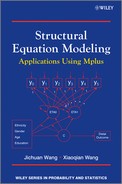1.6 Computer Programs for SEM
A wide variety of computer programs/software has been developed in the past two decades for SEM. The most popular computer programs include LISREL (Jöreskog and Sörbom, 2006), AMOS (Arbuckle, 2006), EQS (Bentler, 1995), Mplus (Muthèn and Muthèn, 1998–2010), SAS PROC CALIS and SAS PROC TCALIS (SAS Institute Inc., 2008). Each computer program has its own strengths and weaknesses, and most structural equation models can be estimated with each of the programs. The choice of program is often down to personal preference.
In this book, the computer program Mplus is used for model demonstration. Mplus was developed on the basis of the computer program LISCOMP (Muthén, 1988). While retaining most of LISCOMP's features for SEM of categorical and continuous data, Mplus comes with some important additions. It allows SEM models with all different types of outcome measures (e.g., continuous, censored, ordinal, nominal, and count variables, as well as a combination of different variable types); it can handle various incomplete data, non-normality, and complex survey data. Additionally, some recently developed advanced models, such as multilevel SEM, mixture models, multilevel mixture models, SEM with exploratory factor analysis, and SEM with Bayesian approach, as well as Monte Carlo simulation, can be readily implemented in Mplus. Overall, Mplus is a user-friendly program that is becoming increasingly popular in SEM.
The models demonstrated in this book are intended to show readers how to build SEM models in Mplus using both cross-sectional and longitudinal data. Mplus syntax for the models is provided in the corresponding chapters of the book. While data used for these examples are drawn from public health studies, the methods and analytical techniques are applicable to SEM practices in many other fields.
